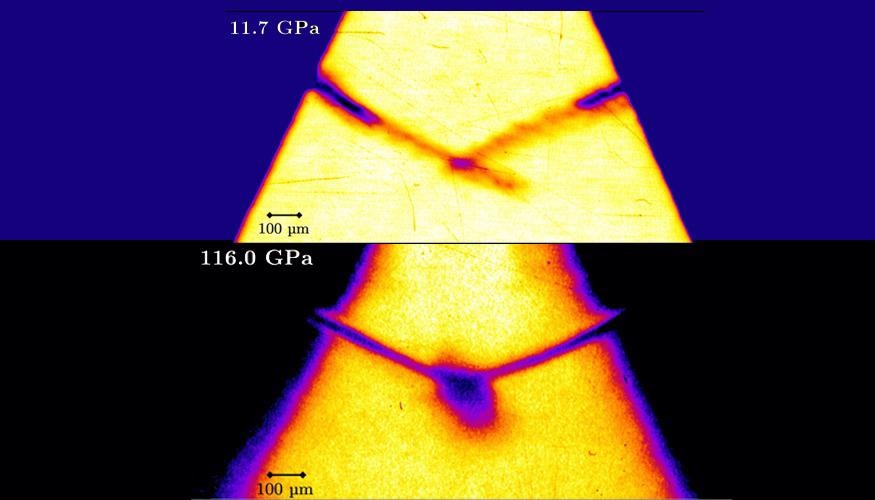There have been limited experimental observations of high-velocity particle-laden flow interactions, given the challenging nature of producing high-velocity flows of many particles.
 This graphic depicts sequences of radiographs of interacting planar tin ejecta microjets. Image Credit: Lawrence Livermore National Laboratory.
This graphic depicts sequences of radiographs of interacting planar tin ejecta microjets. Image Credit: Lawrence Livermore National Laboratory.
Such observations play an essential role in comprehending an extensive range of natural phenomena, spanning from planetary formation to cloud interactions.
That is the case so far. In experiments carried out at the Omega Laser Facility at the University of Rochester’s Laboratory for Laser Energetics (LLE), scientists from Lawrence Livermore National Laboratory (LLNL) have displayed sequences of X-ray radiography images of two interacting tin ejecta microjets for the first time.
The study has been reported in the journal Physical Review Letters and was chosen as an Editor’s Suggestion with LLNL physicist Alison Saunders playing the role as lead author.
These interactions had never been observed before, and so we didn’t really know what to expect. It was surprising to see the lower-density jets from the lower shock pressure pass through each other completely unchanged. This can be thought of as diffuse particle streams passing through each other.
Alison Saunders, Study Lead Author and Physicist, Lawrence Livermore National Laboratory
Furthermore, Saunders stated it was a surprise to discern the higher-density jets from the higher shock pressure interact forcefully.
“We call that the ‘water-hose experiment’ because it looked like we were spraying two water hoses at each other and watching them splash when they hit each other,” she said.
Colliding Tin Ejecta Microjets
The research group considered the first sequence of radiographic images of colliding tin ejecta microjets at two various shock pressures. Ejecta microjets are known to be micron-scale jets of small particles that travel at very high velocities (velocities crossing several kilometers per second, or several thousands of miles per hour).
Two regimes of interaction behavior as a function of shock pressure were noted by the researchers. The jets travel at 2.2 km a second at a shock pressure of 11.7 gigapascals and pass via each other in an unattenuated manner, whereas at a pressure of 116.0 gigapascals, today’s higher-density jets travel at velocities of 6.5 km a second and interact robustly, developing a corona of material near the interaction region.
We also use a simplified collisional model in a radiation hydrodynamics code to model the interactions and find that the model is incapable of reproducing the exact interaction behavior we observe, suggesting that more experiments are needed to understand the physics driving ejecta microjet interaction behavior.
Alison Saunders, Study Lead Author and Physicist, Lawrence Livermore National Laboratory
The scientists utilized OMEGA Extended Performance (EP) with its short-pulse ability to image the jet interactions. Two long-pulse lasers are used to drive shocks into two tin samples that are imprinted with triangular grooves on their free surfaces. As the shocks tend to break out from the free surfaces, the groove features invert to develop planar microjets of material that propagates toward each other.
Thereafter, the EP short-pulse beam that is incident on a microwire produces a bright burst of X-rays that enables the team to take an X-ray radiograph of the jets as they tend to collide. Furthermore, the X-ray radiograph offers quantitative data regarding the jets pre- and post-collision, like jet densities and particle packing inside the jets.
The work provides the first images of ejecta microjet interactions and with that, raises a lot of interesting questions about the physics dominating the collisional behavior. We have reason to believe that the lower-pressure jets may contain more solid material than the jets from the high-pressure shock drives.
Alison Saunders, Study Lead Author and Physicist, Lawrence Livermore National Laboratory
Saunders added that tin is a material that is known to melt over the shock pressures examined in this experiment.
The question arises if the variation in interaction behavior that was noted between the two cases is due to the difference in material phase, or other jet characteristics, including density, velocity or particle-size distributions. The collisions take place with small particles traveling at very high velocities and require very high strain-rate mechanics.
The team has the intention to resolve a few of the physics reservations and comprehend what is forcing the variations that were noted in interaction dynamics: material phase, density, the elasticity of collisions, particle-size distributions or a combination of all of these. As a part of it, the researchers are keen to expand the diagnostic abilities to include various measurements that might be capable of quantifying a few of these properties directly.
The co-authors of the study include Camelia Stan, Kyle Mackay, Brandon Morgan, Jeremy Horwitz, Suzanne Ali, Tomorr Haxhimali, Yuan Ping, Fady Najjar, Jon Eggert, Hye-Sook Park from LLNL and Hans Rinderknecht from LLE.
Journal Reference:
Saunders, A. M., et al. (2021) Experimental Observations of Laser-Driven Tin Ejecta Microjet Interactions. Physical Review Letters. doi.org/10.1103/PhysRevLett.127.155002.